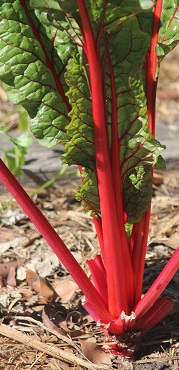Growing Silver Beet and Spinach
 Silver beet, also called "chard" and spinach are two of the easiest vegetables to grow. These are no-fuss plants, given the right conditions.
Silver beet, also called "chard" and spinach are two of the easiest vegetables to grow. These are no-fuss plants, given the right conditions.
They are packed with nutrients including vitamins A, C and E, plus high concentrations of manganese, magnesium, potassium, iron and other minerals as well as riboflavin and B6 and lots of fibre. Although they do have high concentrations of oxalic acid these are reduced by up to 40% in cooking. If you eat it raw limit your intake to around 3 serves per week.
Silverbeet is sometimes mistaken for spinach but they are entirely different plants; silverbeet is actually related to beetroot, its leaves are a lot larger and more fibrous with a thicker central stem than spinach. Silverbeet is also available as ‘Rainbow Chard’ it has lovely coloured stems in reds, yellows etc. which look great on the plate.
Silver beet crops almost year round in temperate or warmer regions, in very cool areas growth may continue in winter but leaves are a lot smaller and may become a bit bitter. Silver beet usually goes to seed at the end of the season but by removing the flowering stem you can extend its life. I prefer to grow new plants each season, old ones become very large taking over a lot of garden space and tend to topple onto nearby plants too.
Spinach is best sown every few weeks in early spring (growing through to early summer) or in mid - to late autumn (for spring harvest). In hot weather it will go to seed quite readily, this is because it is a short day plant (preferring short days to long ones) as the days lengthen it triggers a flowering response in the plant.
What do Silver beet and Spinach Need?
Both like highly fertile well-drained, moist soil. Full sun produces best growth.
Both Silverbeet and spinach like a soil of pH 6-7. This should be easily achieved without adding anything other than manures and fertiliser which acidify the soil slightly. If you have acidic soil (below say pH 6), add some dolomite. You can do this at the same time as adding fertiliser because dolomite doesn’t volatise nitrogen (unlike garden lime which does – so avoid that or use it a few months prior). If you have alkaline soil you can add sulphur if needed but remember that all plants will grow slightly outside of their preferred pH range, without any problems.
Problems with Silver Beet and Spinach
Silver beet is susceptible to many leaf eating insects and miners, snails and slugs. Rust and mildews are problems in warm areas.
Spinach pests include slugs, snails and a range of leaf chewing insects. Diseases include downy mildew, fusarium, leaf spot, rust, damping off and viruses.
- Rust is difficult to eradicate and it is best to remove the plants and start again in a new spot.
- Mildews are controlled by allowing proper spacing between plants encouraging air movement.
- Slugs and snails can be hand removed, or use a beer trap or iron phosphate pellets. Some people suggest a layer of dry material such as sawdust deters snails and slugs as they can’t travel over it – once wet though this may no longer be the case.
- Damping off disease is mainly a problem with young seedlings – avoid mulching too early and keep mulch away from the base of the plant.
- There is no cure for leaf-spot but it can be prevented by a 3 year crop rotation, cleaning away debris around plants. Other preventative measures including spraying with a baking soda solution (this changes the pH of the leaf surface and makes it unattractive to fungal disease) – see recipe. It will not cure existing leaf spot.
Varieties to Try
Silverbeet:
‘Fordhook Giant’ is an old well-known variety with huge leaves. ‘Bright Lights’ or ‘Rainbow Chard’ a seed mix lightly green or bronze crinkled leaves in a range of coloured stems from gold, pink, orange, purple red and white, a sweeter flavour compared to other varieties.
‘Ruby Chard’ – bright red stems and lovely flavour, highly productive and colourful.
‘Silver Ribs’ – an Italian heirloom (open pollinated) variety with shiny, crinkled, dark green leaves and exceptionally white, succulent stems. A large and vigorous, highly productive plant.

Spinach:
‘Baby Leaf’: quick maturing plant gown for its small, sweet leaves, harvest as soon as 6 weeks.
‘Bloomsdale Long Standing’ A hardy spinach with broad, thick, lightly crinkled, flavoursome; also suitable as baby spinach.
'Red Vein' tender flavoursome F1 hybrid variety with red-veined, glossy, dark green leaves on upright plants; also suitable for use as baby spinach. Plants are slow to bolt and disease resistant, so try it in warmer areas:
Spinach 'Galilee': a more heat tolerant variety from the Middle East. The leaves are triangular.
Tyee F1: crinkle leaf spinach with flavoursome leaves, slow to bolt.
You may also be interested in....
Exceptional training for a serious business or career -lots of different options to specialize.
View Course